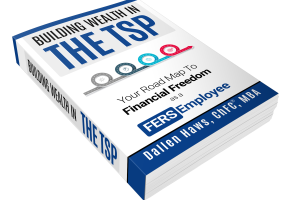If you’re getting close to retirement and feeling nervous about the market, you’re not alone. Volatility makes everyone uneasy. It’s common to hear advice like, “Move your entire TSP to the G Fund three years before retirement.” But is that really a smart move? Let’s talk about it.
The Common Scenario: Fear-Based Decisions
Picture this: the market starts to wobble. Maybe it’s a new crisis—like the 2020 pandemic or a fresh tariff war. Your TSP drops, and suddenly your future feels unstable. You panic. You move everything into the G Fund to “wait it out.”
This instinct may feel safe, but here’s the truth: reacting emotionally and shifting entirely to the G Fund at the wrong time can be catastrophic for your retirement. Why? Because you lock in your losses and miss the recovery.
What the Data Shows
There is a great tool online called “Vanguard Market Hindsight”. Here is a link to it: https://advisors.vanguard.com/financial-planning/market-hindsight/. This tool allows you to see exactly how damaging “selling low” can be. Let’s say you had $1 million in your TSP, invested in a typical 60/40 portfolio (60% in stock-based funds like the C, S, and I Funds, and 40% in more stable assets like the G and F Funds).
When COVID hit in early 2020, markets dropped hard and fast. If you moved everything to the G Fund at the bottom, your $1 million may have dropped to $800,000—and it would have stayed there if you remained in cash or the G Fund. Meanwhile, if you had simply stayed the course, your account could have recovered to $1.1 million or more by the end of that same year. The market rebounded that quickly.
The catch? No one knows when that rebound is coming. If you’re out of the market, you’re likely to miss it. And missing even a few of the best days in the market can drastically lower your long-term returns.
The Real Problem with “All G Fund” Strategies
Now let’s address the myth: “Move everything to the G Fund three years before retirement.” This advice is often passed around at the water cooler, but it’s dangerously outdated and overly simplistic.
In truth, being 100% in the G Fund—especially for several years—can create serious long-term issues. Here’s why:
You Miss Out on Growth: The G Fund is stable, yes. But it doesn’t grow fast enough to outpace inflation over the long term. If you retire at 60 and live to 90, that’s 30 years of retirement. Your money needs to grow just to maintain your standard of living.
You Introduce Inflation Risk: By avoiding market volatility, you’re exposing yourself to a different kind of risk—the risk that your money loses value slowly over time. The G Fund doesn’t keep pace with rising costs in healthcare, food, housing, and energy over a multi-decade retirement.
You Eliminate Recovery Potential: Markets are cyclical. They go down, but they also go up. Pulling out when things dip and failing to re-enter quickly enough can cost you hundreds of thousands in missed recovery.
A Better Strategy: Balance and Planning
So what’s a smarter approach? Great strategies that have been proven to work include the “bucket system” and the “4% Rule”. Here is a great article explaining these strategies: https://hawsfederaladvisors.com/using-the-4-rule-bucket-strategy-for-your-tsp/
The goal is simple: have enough in stable investments to cover near-term withdrawals, while allowing the rest to grow over time. If the market dips, you use your G Fund money to live on. Meanwhile, your stock funds can rebound without forcing you to sell low.
You don’t need to be a robot. It’s natural to feel nervous. But having a plan—and sticking to it—is critical. Your TSP shouldn’t be guided by emotions or hearsay, but by a strategy tailored to your goals.
Final Thoughts: The Danger of Water Cooler Wisdom
Here’s the big takeaway: decisions based on rumors or outdated advice can cost you far more than you realize. Don’t fall for one-size-fits-all strategies. What works for your coworker may not be right for you.
The conventional wisdom of “move to the G Fund near retirement” isn’t grounded in solid financial planning. It might feel safe, but it doesn’t offer the growth most federal employees need to support a long, comfortable retirement.
Instead, aim for a mix—some safe money, yes—but also some growth-oriented investments to help your nest egg last. Be diligent. Be disciplined. Know your plan, and stick to it—even when the market gets bumpy.
If you’re not sure what kind of allocation is right for you, don’t guess. Do the research, or better yet, work with a professional who understands federal benefits and the unique needs of TSP investors. You can always check out resources at HawsFederalAdvisors.com to learn more.
Your retirement deserves more than cookie-cutter advice. Get informed, get balanced, and stay the course.


